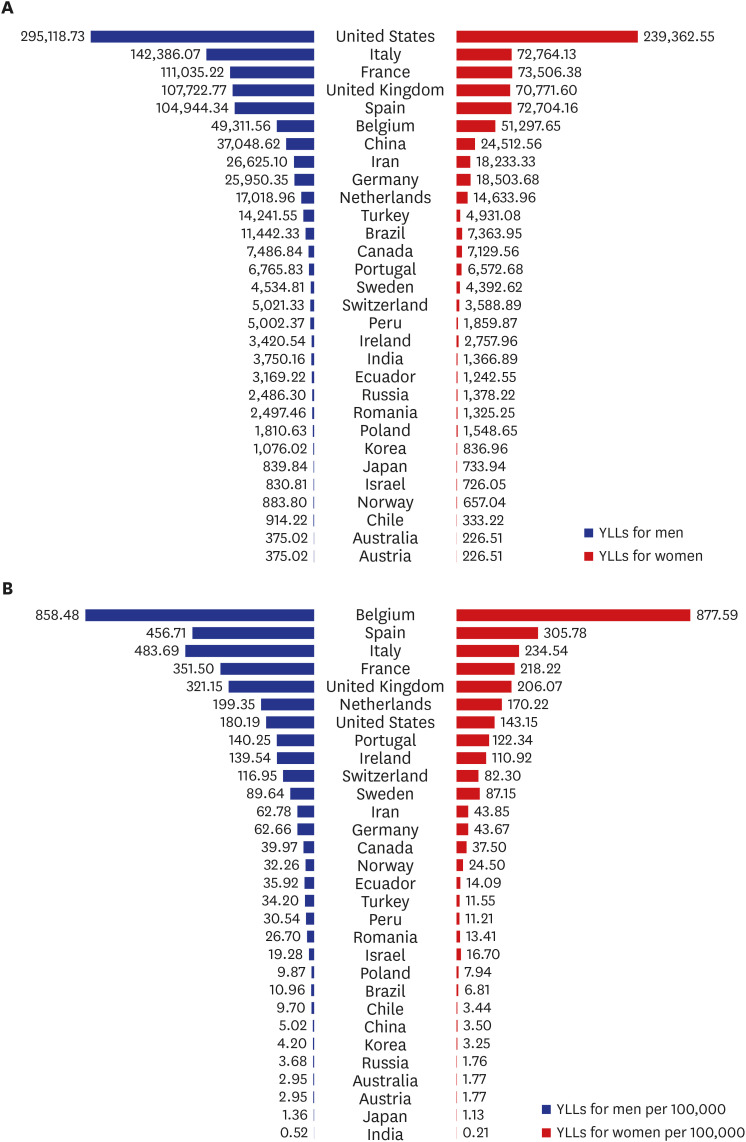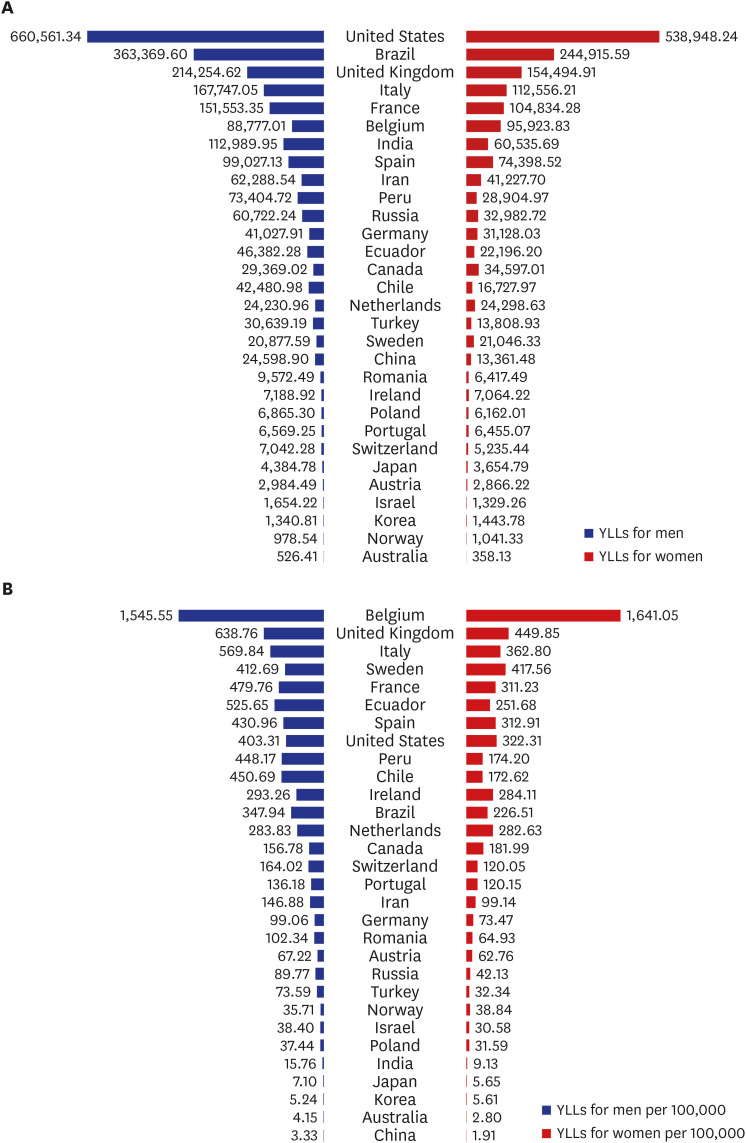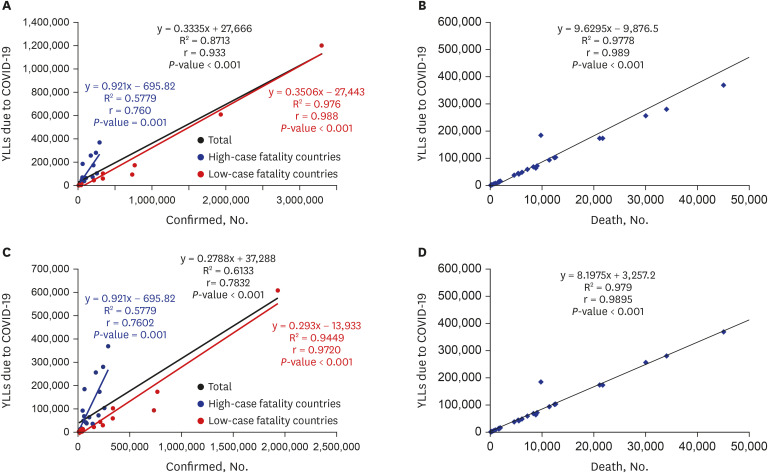J Korean Med Sci.
2020 Aug;35(32):e300. 10.3346/jkms.2020.35.e300.
Years of Life Lost Attributable to COVID-19 in High-incidence Countries
- Affiliations
-
- 1Department of Preventive Medicine, School of Medicine, Kyung Hee University, Seoul, Korea
- 2Department of Preventive Medicine, University of Ulsan College of Medicine, Seoul, Korea
- 3Department of Preventive Medicine, Ulsan University Hospital, Ulsan, Korea
- 4Department of Health Care Policy Research, Korea Institute for Health and Social Affairs, Sejong, Korea
- 5Big Data Department, National Health Insurance Service, Wonju, Korea
- 6Department of Public Health, Graduate School, Korea University, Seoul, Korea
- 7Department of Preventive Medicine, Ewha Womans University School of Medicine, Seoul, Korea
- 8Department of Preventive Medicine, Korea University College of Medicine, Seoul, Korea
- KMID: 2505587
- DOI: http://doi.org/10.3346/jkms.2020.35.e300
Abstract
- Background
The coronavirus disease 2019 (COVID-19) pandemic is a major public health problem of international concern. It is important to estimate its impact of COVID-19 for health policy decision-making. We estimated the years of life lost (YLLs) due to COVID-19 in high-incidence countries.
Methods
We collected the YLLs due to COVID-19 in 30 high-incidence countries as of April 13, 2020 and followed up as of July 14, 2020. Incidence and mortality were collected using each country's formal reports, articles, and other electronic sources. The life expectancy of Japanese females by age and the UN population data were used to calculate YLLs in total and per 100,000.
Results
As of April 22, 2020, there were 1,699,574 YLLs due to COVID-19 in 30 high-incidence countries. On July 14, 2020, this increased to 4,072,325. Both on April 22 and July 14, the total YLLs due to COVID-19 was highest in the USA (April 22, 534,481 YLLs; July 14, 1,199,510 YLLs), and the YLLs per 100,000 population was highest in Belgium (April 22, 868.12 YLLs/100,000; July 14, 1,593.72 YLLs/100,000). YLLs due to COVID-19 were higher among males than among females and higher in those aged ≥ 60 years than in younger individuals. Belgium had the highest proportion of YLLs attributable to COVID-19 as a proportion of the total YLLs and the highest disability-adjusted life years per 100,000 population.
Conclusion
This study estimated YLLs due to COVID-19 in 30 countries. COVID-19 is a high burden in the USA and Belgium, among males and the elderly. The YLLs are very closely related with the incidence as well as the mortality. This highlights the importance of the early detection of incident case that minimizes severe acute respiratory syndrome coronavirus-2 fatality.
Figure
Cited by 1 articles
-
Risk Factors of Outcomes of COVID-19 Patients in Korea: Focus on Early Symptoms
Su Yeon Jang, Jeong-Yeon Seon, Baik-Lin Eun, Seong-Beom Koh, Jin-Hong Yoo, Woo Yong Lee, Ho-Kee Yum, Seok-Jun Yoon, In-Hwan Oh, Sang-Cheol Bae, Sung-Goo Chang
J Korean Med Sci. 2021;36(18):e132. doi: 10.3346/jkms.2021.36.e132.
Reference
-
1. Wang C, Horby PW, Hayden FG, Gao GF. A novel coronavirus outbreak of global health concern. Lancet. 2020; 395(10223):470–473. PMID: 31986257.
Article2. World Health Organization. Naming the coronavirus disease (COVID-19) and the virus that causes it. Updated 2020. Accessed April 28, 2020. https://www.who.int/emergencies/diseases/novel-coronavirus-2019/technical-guidance/naming-the-coronavirus-disease-(covid-2019)-and-the-virus-that-causes-it.3. World Health Organization. WHO Director-General's opening remarks at the media briefing on COVID-19 – 11 March 2020. Updated 2020. Accessed April 27, 2020. https://www.who.int/dg/speeches/detail/who-director-general-s-opening-remarks-at-the-media-briefing-on-covid-19---11-march-2020.4. World Health Organization. Coronavirus disease (COVID-19) pandemic. Updated 2020. Accessed April 28, 2020. https://www.who.int/emergencies/diseases/novel-coronavirus-2019.5. Murray CJ, Vos T, Lozano R, Naghavi M, Flaxman AD, Michaud C, et al. Disability-adjusted life years (DALYs) for 291 diseases and injuries in 21 regions, 1990–2010: a systematic analysis for the Global Burden of Disease Study 2010. Lancet. 2012; 380(9859):2197–2223. PMID: 23245608.6. World Health Organization. Coronavirus disease (COVID-19) situation dashboard. Updated 2020. Accessed April 28, 2020. https://covid19.who.int/.7. Global Health 5050. COVID-19 sex-disaggregated data tracker. Updated 2020. Accessed April 28, 2020. https://globalhealth5050.org/covid19/#1586352650173-d9a8b64b-670a.8. Ministry of Health, Labor and Welfare. The 22nd life tables (2015). Updated 2020. Accessed April 29, 2020. https://www.mhlw.go.jp/english/database/db-hw/lifetb22nd/dl/tables.pdf.9. United Nations Department of Economic and Social Affairs Population Dynamics. World population prospects 2019. Updated 2020. Accessed April 28, 2020. https://population.un.org/wpp/Download/Standard/Population/.10. James SL, Abate D, Abate KH, Abay SM, Abbafati C, Abbasi N, et al. Global, regional, and national incidence, prevalence, and years lived with disability for 354 diseases and injuries for 195 countries and territories, 1990–2017: a systematic analysis for the Global Burden of Disease Study 2017. Lancet. 2018; 392(10159):1789–1858. PMID: 30496104.11. Alimohamadi Y, Taghdir M, Sepandi M. The estimate of the basic reproduction number for novel coronavirus disease (COVID-19): a systematic review and meta-analysis. J Prev Med Public Health. 2020; 53(3):151–157. PMID: 32498136.12. Walker PG, Whittaker C, Watson O, Baguelin M, Ainslie KE, Bhatia S, et al. The Global impact of COVID-19 and strategies for mitigation and suppression. Updated 2020. Accessed April 28, 2020. https://www.preventionweb.net/publications/view/71077.13. Kang YJ. Mortality rate of infection with COVID-19 in Korea from the perspective of underlying disease. Disaster Med Public Health Prep. 2020; 1–3.
Article14. Armitage R, Nellums LB. COVID-19 and the consequences of isolating the elderly. Lancet Public Health. 2020; 5(5):e256. PMID: 32199471.
Article15. Her M. How is COVID-19 affecting South Korea? What is our current strategy? Disaster Med Public Health Prep. 2020; 1–3.
Article
- Full Text Links
- Actions
-
Cited
- CITED
-
- Close
- Share
- Similar articles
-
- The Burden of Disease due to COVID-19 in Korea Using Disability-Adjusted Life Years
- Osteonecrosis following Steroid Therapy in COVID-19 Patients: An Outlook on the Emerging Problem
- Association between face covering policies and the incidence of coronavirus disease 2019 in European countries
- Factors Affecting Fear of COVID-19 Infection in Healthcare Workers in COVID-19 Dedicated Teams: Focus on Professional Quality of Life
- Social and Policy Determinants of COVID-19 Infection Across 23 Countries: An Ecological Study




